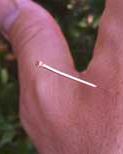The acupuncture group received acupuncture at LI4 with a 0.25 X 25mm needle to a depth of 15mm. Manual stimulation to the needle was applied with the rotation method every five minutes for a total of 30 minutes. In the control group, subjects did not receive acupuncture.Acupuncture Affects Opposite Side
Acupuncture stimulation of right-sided LI4 caused strong amplification of the mean blood flux on the left-sided LI4. However, needling of left-sided LI4 only caused moderate amplification on both sides. The researchers concluded that the acupuncture point LI4 has lateralized specificity.More Specificity Research
 Acupuncture at LI4Researchers from the University of California, School of Medicine in Irvine, California concluded, “Recent evidence shows that stimulation of different points on the body causes distinct responses in hemodynamic, fMRI and central neural electrophysiological responses.” MRI results showed that “stimulation of different sets of acupoints leads to disease-specific neuronal responses, even when acupoints are located within the same spinal segment.” New MRI research demonstrates that acupuncture “induce(s) different cerebral glucose metabolism changes in pain-related brain regions and reduce(s) intensity of pain” for patients with migraines. The choice of acupuncture points determined specific changes in brain glycometabolism, indicating point specificity. New research published in the American Journal of Chinese Medicine concludes that acupuncture at acupoint SP9 (Yinlingquan) increases blood flow/perfusion to the spleen and acupuncture at acupoint LV8 (Ququan) increases blood flow/perfusion to the liver. The researchers concluded, “These results provide scientific evidence of the specificity of meridians.”A recent MRI study compared brain activity from needling acupoint SP6 with a sham point. SP6 increased activity in the inferior parietal lobe, fusiform temporal gyrus and medial frontal gyrus. The sham point did not activate the areas but instead enhanced activity in the precuneus, a part of the superior parietal lobe. The researchers concluded that true acupuncture affects brain activity differently than needle stimulation at non-acupuncture points. A recent study concludes, “Acupuncture is effective in the treatment of functional dyspepsia, and is superior to non-acupoint puncture. The benefit of acupuncture relies on acupoint specificity.” The control group sham points were ineffective in the treatment of dyspepsia whereas the use of Stomach channel acupoints had over a 70 percent success rate.New research published in the Journal of Magnetic Resonance Imaging demonstrates the point specific neurophysiological effects of acupuncture using MRI technology. Stimulation of acupuncture point GB40 (Qixu) enhanced “connectivity between the superior temporal gyrus (STG) and anterior insula.” Acupuncture point K3 (Taixi) increased the connection strength between the STG and the postcentral gyrus. The researchers concluded that, “The current study demonstrates that acupuncture at different acupoints could exert different modulatory effects on RSNs (brain Resting State Networks). Our findings may help to understand the neurophysiological mechanisms underlying acupuncture specificity.”
Acupuncture at LI4Researchers from the University of California, School of Medicine in Irvine, California concluded, “Recent evidence shows that stimulation of different points on the body causes distinct responses in hemodynamic, fMRI and central neural electrophysiological responses.” MRI results showed that “stimulation of different sets of acupoints leads to disease-specific neuronal responses, even when acupoints are located within the same spinal segment.” New MRI research demonstrates that acupuncture “induce(s) different cerebral glucose metabolism changes in pain-related brain regions and reduce(s) intensity of pain” for patients with migraines. The choice of acupuncture points determined specific changes in brain glycometabolism, indicating point specificity. New research published in the American Journal of Chinese Medicine concludes that acupuncture at acupoint SP9 (Yinlingquan) increases blood flow/perfusion to the spleen and acupuncture at acupoint LV8 (Ququan) increases blood flow/perfusion to the liver. The researchers concluded, “These results provide scientific evidence of the specificity of meridians.”A recent MRI study compared brain activity from needling acupoint SP6 with a sham point. SP6 increased activity in the inferior parietal lobe, fusiform temporal gyrus and medial frontal gyrus. The sham point did not activate the areas but instead enhanced activity in the precuneus, a part of the superior parietal lobe. The researchers concluded that true acupuncture affects brain activity differently than needle stimulation at non-acupuncture points. A recent study concludes, “Acupuncture is effective in the treatment of functional dyspepsia, and is superior to non-acupoint puncture. The benefit of acupuncture relies on acupoint specificity.” The control group sham points were ineffective in the treatment of dyspepsia whereas the use of Stomach channel acupoints had over a 70 percent success rate.New research published in the Journal of Magnetic Resonance Imaging demonstrates the point specific neurophysiological effects of acupuncture using MRI technology. Stimulation of acupuncture point GB40 (Qixu) enhanced “connectivity between the superior temporal gyrus (STG) and anterior insula.” Acupuncture point K3 (Taixi) increased the connection strength between the STG and the postcentral gyrus. The researchers concluded that, “The current study demonstrates that acupuncture at different acupoints could exert different modulatory effects on RSNs (brain Resting State Networks). Our findings may help to understand the neurophysiological mechanisms underlying acupuncture specificity.”
No comments:
Post a Comment